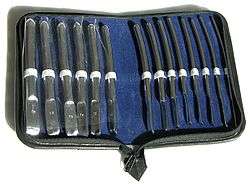Hegar dilators
Hegar dilators are dilators used to treat vaginismus, induce cervical dilation, and for inflatable penile implant procedures.[1][2]

Description
Hegar dilators were developed and introduced by Alfred Hegar in 1879.[3] Typically, dilators are a set of metal rods of increasing diameters, from a few millimeters up to 26 millimeters. The rods are round, slightly curved, and have a conal tip. Some sets have conal tips at both ends, while others have one end flattened for handling. Hegar dilators are marked with a Hegar number equivalent to 0.5 millimeters.
Use in the treatment of vaginismus
Hegar dilators are used to treat vaginismus, also known as genito-pelvic pain disorder.[2][1] Females with vaginismus use Hegar dilators of gradually increasing size, followed by penetration from their male partner.[4]
Cervical procedure use
Hegar dilators are used to induce cervical dilation in order to gain entry to the interior of the uterus.
During the process of dilation, the cervix may have to be stabilized with a tenaculum, and then the dilators are slowly entered into the cervical canal with a lubricant, starting with a thin, low Hegar number rod and progressing gradually to larger numbers.[5] The dilators can also be used to sound the uterus.
Hegar dilators are widely used in gynecology to open up the cervix. This may be necessary prior to a uterine curettage or biopsy. They have also found application in the management of vaginismus or hymenal stenosis.[6] They are also used to overcome stenosis in non-gynecological situations, such as in urology and proctology.
Laminaria rods have also been used to open up the cervix but work slowly as they increase size by absorbing water.
Penile implant procedure use
Hegar dilators (commonly, sizes 11 and 12) are used during the insertion of two intracorporal cylinders into the Corpus cavernosum penis as part of an Inflatable penile implant procedure. These cylinders are inflated and deflated by a pump that moves sterile saline under pressure between a holding reservoir and the cylinders, inflating or deflating an erection of the penis.[7]
References
- The Urologic and Cutaneous Review, Volume 52. Urologic & Cutaneous Press. 1948. p. 129.
- Doleys, Daniel (6 December 2012). Behavioral Medicine. Springer Science & Business Media. p. 377. ISBN 9781468440706.
- M Tschoudowski: De la dilatation du canal cervical (d’après Hegar). (1879) Arch Tocol 6: 737–755
- Fuchs K (1980). "Therapy of vaginismus by hypnotic desensitization". American Journal of Obstetrics & Gynecology. 137 (1): 1–7. doi:10.1016/0002-9378(80)90376-2. PMID 6102843.
- Hellman LM, Pritchard JA. Williams Obstetrics, 14th edition. Appleton Century Croft, 1971. p. 1089f.
- Segal TR, Fried WB, Krim EY, Parikh D, Rosenfeld DL (2015). "Treatment of microperforate hymen with serial dilation: a novel approach". J Pediatr Adolesc Gynecol 2015 (Apr),28(2):e21-2. 28 (2): e21–2. doi:10.1016/j.jpag.2014.06.001. PMID 25444056.
- Al-Shaiji, TariqF; Al-Enezi, Ahmad; Al-Khadhari, Sulaiman (2011). "Three-piece inflatable penile prosthesis: Surgical techniques and pitfalls". Journal of Surgical Technique and Case Report. 3 (2): 76–83. doi:10.4103/2006-8808.92798. PMC 3296438. PMID 22413049.